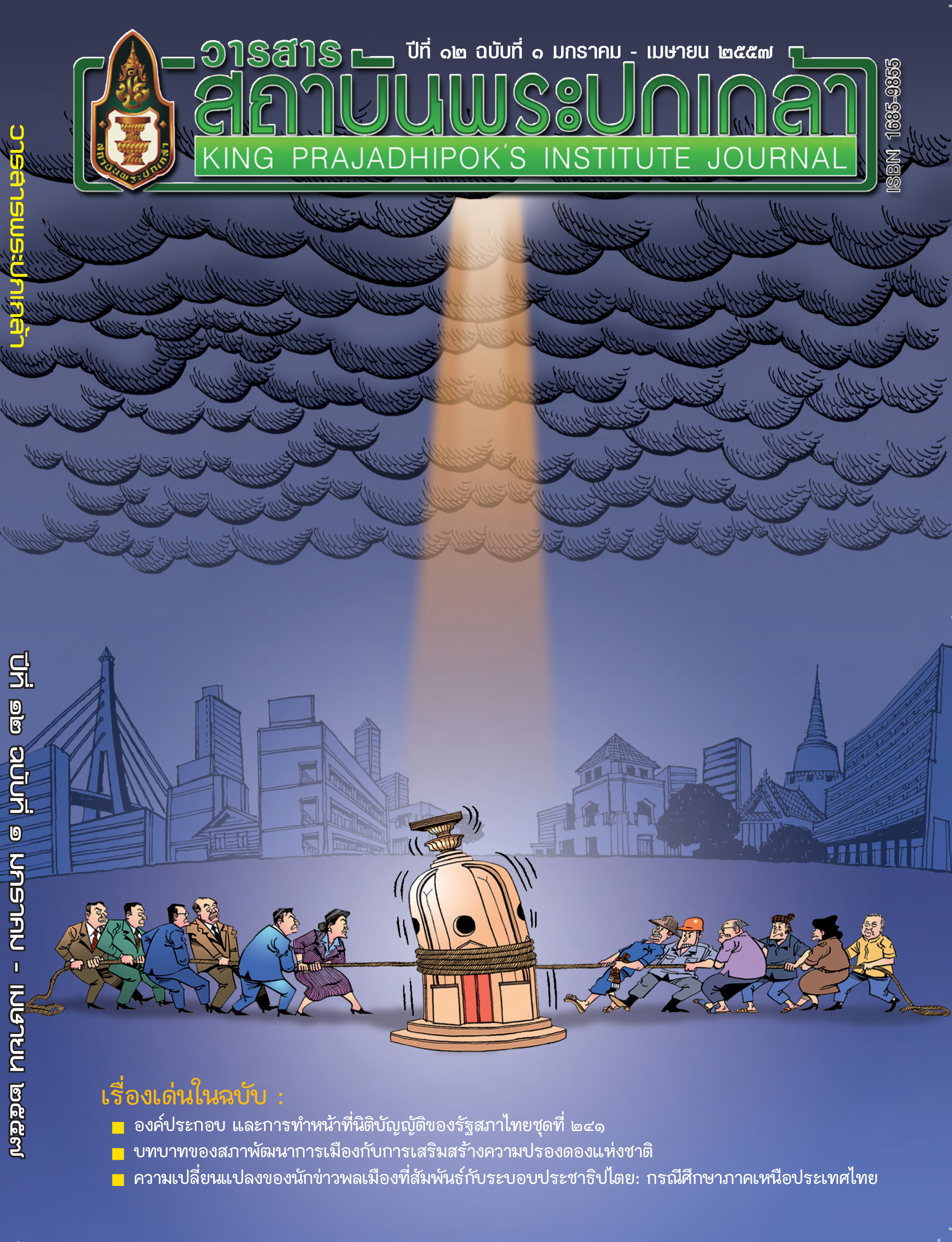Party Leader and Political Party: Factors behind Thai People’s Electoral Behavior in the 2007 General Election
Main Article Content
Abstract
This article is a study of Thais’ Electoral Behavior in the 2007 general election. It aims to identify factors behind voting decisions. It found that factors that drive people to vote the way they did are “party and party leader’s image.” In other words, the popularity of the party and the party leader influence voters’ decisions. Moreover, the results refuted the conventional wisdom that voters’ region of origin and place of residence are
the factors that drive them to vote for any particular party.
Article Details
@ 2020 King Prajadhipok's Institute The Government Complex Commemorating All Right Reserved.
References
สถาบันพระปกเกล้า สำนักวิจัยและพัฒนา. ๒๕๔๕. รายงานการวิจัย เรื่อง พฤติกรรมการเลือกตั้งและปัจจัยในการตัดสินใจเลือกตั้งสมาชิกวุฒิสภา พ.ศ. ๒๕๔๓. กรุงเทพฯ: ธรรมกมลการพิมพ์.
สถาบันพระปกเกล้า (สำนักวิจัยและพัฒนา). ๒๕๔๘. การเมืองไทยในการเลือกตั้งทั่วไป ๒๕๔๘. กรุงเทพฯ: พาณิชพระนคร.
สุจิต บุญบงการ และ พรศักดิ์ ผ่องแผ้ว. ๒๕๒๗. พฤติกรรมการลงคะแนนเสียงเลือกตั้งของคนไทย. กรุงเทพฯ: โรงพิมพ์จุฬาลงกรณ์มหาวิทยาลัย.
เอนก เหล่าธรรมทัศน์. ๒๕๔๖. สองนคราประชาธิปไตย: แนวทางปฏิรูป การเมือง เศรษฐกิจ เพื่อประชาธิปไตย. กรุงเทพฯ: ทิปปิ้ง พอยท์ เพรส.
Abramson, Paul R., John H. Aldrich, and David W. Rohde. 2004. Change and Continuity in the 2004 Elections. Washington, DC: CQ press.
Campbell Angus, Philip E. Converse, Warren E. Miller, and Donald E. Stokes. 1960. The American voter. New York: John Wiley & Sons, Inc.
Clarke, Harold D., Allan Kornberg, and Thomas J. Scotto. 2009. Making Political Choices: Canada and the United States. Toronto: University of Toronto Press.
Converse, Phillip E. 1964. “The Nature of Belief Systems in Mass Publics” In Ideology and Discontent, ed. David E. Apter. London: Free Press of Glencoe, 206-261.
Downs, Anthony. 1957. An Economic Theory of Democracy. New York: Harper & Row.
Lazarsfeld, Paul Felix, Bernard Berelson, and Hazel Gaudet. 1948. The People’s Choice: How the Voter Makes up His Mind in a Presidential Campaign 2nd ed. New York: Columbia University Press.
Long, J. Scott. 1997. Regression Models for Categorical and Limited Dependent Variables. Thousand Oaks, CA: Sage Publications.
Riker, William H., and Peter C. Ordershook. 1968. “A Theory of the Calculus of Voting.” American Political Science Review 62 (March): 25-43.
Schumpeter, Joseph. 1976. Capitalism, Socialism, and Democracy. London: Allen and Unwin.
Sniderman, Paul M., Richard A. Brody, and Phillip Tetlock. 1991. Reasoning and Choice: Explorations in Political Psycology. Cambridge: Cambridge University Press.
Stokes, Donald E. 1992. “Valence Politics.” In Electoral Politics, ed. Dennis Kavanagh. Oxford: Clarendon Press, 141-164.
Stokes, Donald E. 1963. “Spatial Models of Party Competition.” American Political Science Review 57: 368-377.


